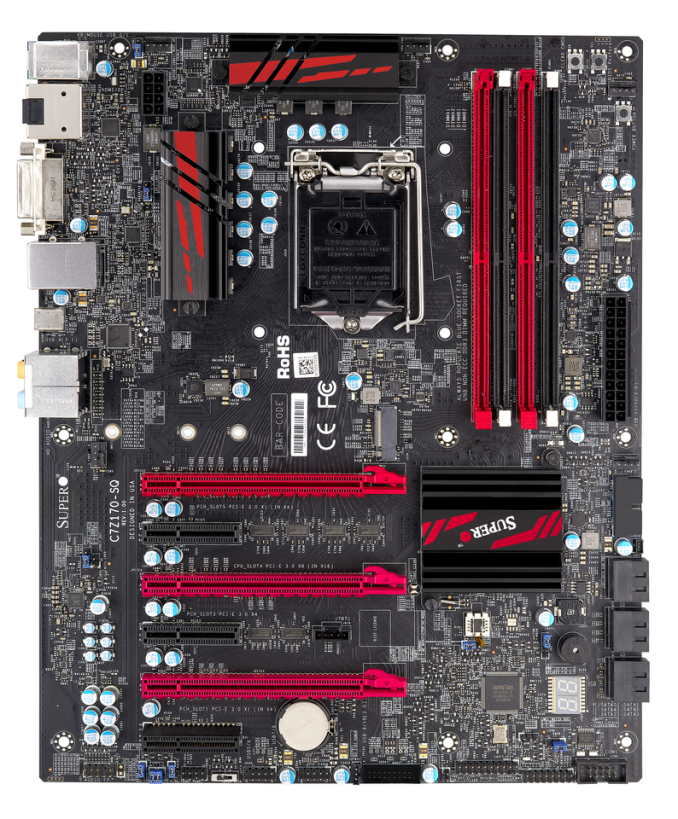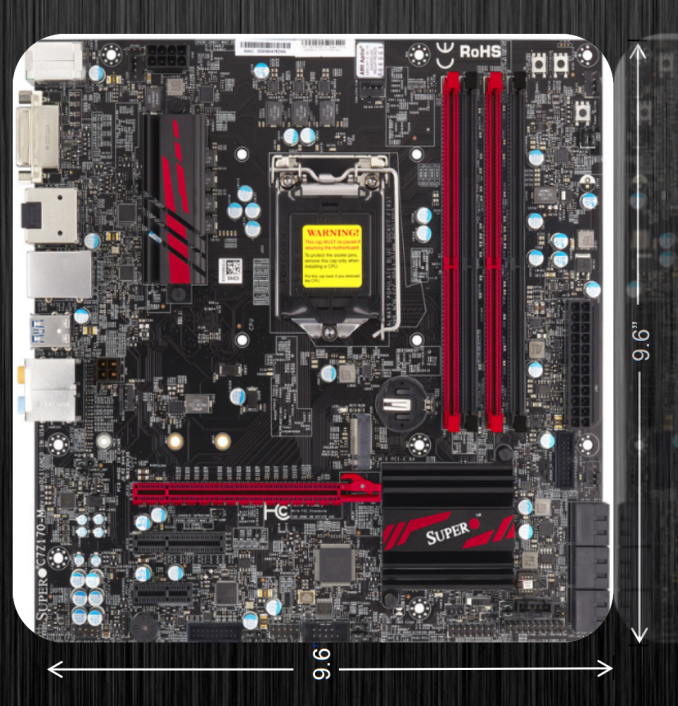Intel Skylake Z170 Motherboards: A Quick Look at 55+ New Products
by Ian Cutress on August 5, 2015 7:59 AM ESTSupermicro Z170
When you mention a consumer motherboard, the name Supermicro does not shout loud from the rooftops. Supermicro is more commonly associated in the server industry with a large chunk of market share for providing enterprise platforms that power a number of industries and government departments. Technically they have had consumer motherboard products now for a couple of years, sticking with a low number of models to test the waters. Supermicro relies more on the name of the brand and the engineer expertise in the server space to carry their product forward. For Z170, they have informed me that at this point two models are in the works although there are some final decisions to be made particularly about coloring and style, so the following pictures may not represent final product.
Supermicro C7Z170-SQ
The SQ is the ATX model, with Supermicro using the red and black color scheme of other Gaming lines to apply it to their own brand.
Here is what looks like a mid-range motherboard sporting an x8/x4/x4 PCIe 3.0 layout in red with x4/x1/x1 in the other black slots from the chipset. The PCIe layout is slightly different to other mainstream boards by virtue of the M.2 slot above them which operates in PCIe 3.0 x4 mode. Because of the arrangement, it means we have a sub-optimal PCIe card placement for dual GPU setups, whereby the top two red PCIe lanes are used which does not leave a ventilation gap which is usually important in a consumer design.
In terms of hardware support, we get six SATA ports, a single USB 3.1 Type-C port on the rear panel due to an ASMedia ASM1142 controller, an Intel I219-V network port and a Realtek ALC1150 audio solution. Unlike some other boards we get a couple of server features, such as TPM and SATA DOM, as well as all five fan headers on board being 4-pin. It will be interesting to see how Supermicro has developed its BIOS and software especially in light of the stiff competition of the regular consumer motherboard manufacturers in this area
Supermicro C7Z170-M
The M is for micro-ATX, and it looks like Supermicro is aiming at something more for the cost conscious user here:
For graphics there is a single PCIe 3.0 x16 slot and no second slot like other micro-ATX motherboards for a second card. Instead we get a fixed with PCIe 3.0 x4 slot and a PCIe x1 slot for good measure. Other functionality is similar to that of the full sized motherboard with six SATA ports, an Intel I219-V for network, a Realtek ALC1150 audio codec and an M.2 slot running in PCIe 3.0 x4 mode. Where the micro-ATX differs is in the power delivery heatsinks and this time the USB 3.1 capabilities have shifted from a single Type-C to two Type-A ports.
At this point pricing for these boards is unknown but a sample of the C7Z170-SQ just came in through the door. We will be testing it in due course.


















85 Comments
View All Comments
Norseman4 - Wednesday, August 5, 2015 - link
I'm looking at mITX boards and I saw 3 that are worthwhile (sorry ECS) that has an M.2 port, or a position on the board either stating M.2 or showing the screw positions for it. Only one of them had descriptions about it. (ASUS Z170i Pro Gaming)What of the Gigabyte Z170N-WIFI? The port is on the underside of the board, but I don't know if it's strictly SATA or not.
The EVGA Stinger looks good, but it needs something else before it can be used. Will this be dedicated to a WIFI card like previous versions or can an M.2 drive be used?
Norseman4 - Wednesday, August 5, 2015 - link
Follow up: The EVGA Stinger has a daughter card that converts those pins to M.2 Key E configuration, not B or M that seem to be used for drives.Rauwomos - Thursday, August 6, 2015 - link
Does that mean it has no chance of being used for an M.2 drive then as it is solely an E Keyed M.2 port, is it being converted from a useable key to an e key?Norseman4 - Thursday, August 6, 2015 - link
http://www.evga.com/Products/Product.aspx?pn=111-S...The 20pin socket that's marked M.2 is converted to a M.2 Key E using a daughterboard. I have not seen any drives in the Key E format, so it looks like it's just for something else.
http://www.hwtools.net/PDF/M2%20Adapter%20Selectio...
Norseman4 - Wednesday, August 5, 2015 - link
MSI has information for the Z170i Gaming Pro AC, which lists Turbo M.2. I haven't read what that just yet though. (Source: Tom's Hardware)Norseman4 - Wednesday, August 5, 2015 - link
From an older post about MSI's X99 boards, Turbo M.2 = M.2 Gen 3.0 x4 (All of their Z170 boards have at least 1)Dahak - Wednesday, August 5, 2015 - link
The USB Gen thing was a result of the USB-IF when they release usb 3.1, apple, msi is technically correct as they are following the proper naming.Yes its confusing to regular customers.
Impulses - Wednesday, August 5, 2015 - link
I'm happy with my MSI P67 board but I think I wanna go ASUS this time, that Z170-A looks like a good no nonsense no frills board... And the Z97/X99-A both reviewed pretty well. Kinda light on USB ports but whatever... All I really care for is a decent layout, solid software, and M.2 for an SM951.vLsL2VnDmWjoTByaVLxb - Wednesday, August 5, 2015 - link
"In the previous Z97 chipset, there are a total of 18 Flex-IO ports that can flip between PCIe lanes, USB 3.0 ports or SATA 6 Gbps ports. For Z97, this moves up to 26 and can be used in a variety of configurations:"I think you mean Z170 in that second paragraph.
Ryan Smith - Wednesday, August 5, 2015 - link
Indeed we do. Thanks.